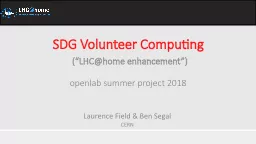

LHChome enhancement openlab summer project 2018 Laurence Field amp Ben Segal CERN Volunteer Computing A type of distributed computing using public volunteers SETI home ID: 800306
Download The PPT/PDF document "SDG Volunteer Computing" is the property of its rightful owner. Permission is granted to download and print the materials on this web site for personal, non-commercial use only, and to display it on your personal computer provided you do not modify the materials and that you retain all copyright notices contained in the materials. By downloading content from our website, you accept the terms of this agreement.
Slide1
SDG Volunteer Computing
(“
LHC@home enhancement”)openlab summer project 2018
Laurence Field & Ben SegalCERN
Slide2Volunteer ComputingA type of distributed computing using
public volunteersSETI@home
(1999), Folding@home (2000)LHC@home launched in 2004Computer owners donate computing capacity
To a cause or projectNot necessarily only spare cycles on Desktop PC’sIdle machines in data centersHome clustersTablets or phones …
Slide3LHC@home (2004)
Accelerator design by beam simulation
Slide4Africa@home (2006)
Modelling the epidemiology of malaria in Africa with Swiss Tropical Institute
Slide5Project with Tsinghua Univ, IBM World Community Grid
Simulating enhanced water flow through nanotubes
Accuracy at low v needs large samples (~10
5
CPU-years)
IBM WCG projects preloaded on Sony Vaios in USA
CAS@home (2009)
Simulation of nanotech water filters
Slide6Asia@home (2010)
volunteer seismic detection and science
Slide7Citizen Cyberlab
Learning and creativity in citizen cyberscience (EU FP7)
Slide8BOINC
Berkeley Open Infrastructure for Network ComputingStarted in 2002 by
SETI@home teamFunded by the National Science Foundation (NSF) Developed by a team based at the Space Sciences LaboratoryUniversity of California, BerkeleyLed by David Anderson
Provides open middleware for volunteer computingClient (Mac, Windows, Linux, Android) with CLIGUIApplication runtime systemServer softwareProject Web site
Slide9Volunteer Perspective
Download and run the BOINC client
Choose a project
Enter an email address and password Or silent connection with a keyRun the application and earn credit
Slide10Why do volunteers participate?
Cool screensaver
Message boards
Credit for processing
Slide11Motivation for a BOINC project
Free* resources100K hosts achievable for large projects
Actual job slot count (number of cores) maybe even higherCommunity engagementOutreach channelExplaining the purpose and value of the scienceParticipationOffering people a chance to contribute
Engagement forms a strong bond Community support* (But there are some costs required to use them!)
Slide12Challenges to solve
The cost of using the “free” resources
Initial software integration requires investmentOperations and MaintenancePublic facing support on all levels (but lowered by support from the community itself!)
Attracting and retaining volunteersAdvertisement and engagementCommunications cost for capacity buildingLow Level of AssuranceAnyone can register as a volunteer(not the same level of trust as with the Grid)Running HEP software on WindowsWindows systems are till 85% of the resources !!CERN solved this problem by using VIRTUALISATION
Slide13BOINC with Virtualization
Slide14Our Usage of BOINC at CERNA single project “LHC@home” with multiple applications
Reduced operational costsSingle forumOne serviceSimplified for the volunteers
One project to attach to instead of severalSingle user name and passwordBoth classic and virtualised applications run togetherSixtrack (“classic”)
Test4theory, ATLAS, CMS, LHCb and ALICE(“virtualised”) - because HEP software only runs on Linux
Slide15http://cern.ch/lhcathome
Slide16Current LHC@home Applications
Slide172018 Summer Student project
The summer student project:
Create new applications for SDG researchers:Working with University of Geneva teams
Demonstrate R language and Machine Learning capabilitiesPrototype the applications first in a private cloud clusterPort prototypes to BOINC / LHC@home for Volunteer Computing
Slide182018 Summer Student project
The summer student project:
First time Google’s system “Tensor Flow” used in BOINCBuild, train and exploit Neural Networks for SDG applicationsAllows the volunteers’ GPU’s to be used as well as CPU’s
Slide19SummaryVolunteer Computing can and is providing:Significant additional computing resources
Potentially O(100K) machinesVirtualisation enables HEP applicationsTo run on
multiple platforms: Windows, Mac and LinuxCan therefore reach more volunteersLHC@home is a common platformSupporting multiple
applications, now including SDG applicationsCome and join the fun!http://lhcathome.web.cern.ch/join-us